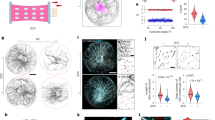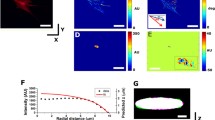Abstract
The state of crosslinking of microfilaments and the state of myosin-driven contraction are the main determinants of the mechanical properties of the cell cortex underneath the membrane, which is significant for the mechanism of shaping cells. Therefore, any change in the contractile state of the actomyosin network would alter the mechanical properties and finally result in shape changes. The relationship of microtubules to the mechanical properties of cells is still obscure. The main problem arises because disruption of microtubules enhances acto-myosin-driven contraction. This reaction and its impact on cell shape and elasticity have been investigated in single XTH-2 cells. Microtubule disruption was induced by colcemid, a polymerization inhibitor. The reaction was biphasic: a change in cell shape from a fried egg shape to a convex surface topography was accompanied by an increase in elastic stiffness of the cytoplasm, measured as longitudinal sound velocity revealed by scanning acoustic microscope. Elasticity increases in the cell periphery and reaches its peak after 30 min. Subsequently while the cytoplasm retracts from the periphery, longitudinal sound velocity (elasticity) decreases. Simultaneously, a two- to threefold increase of F-actin and alignment of stress fibers from the cell center to cell-cell junctions in dense cultures are induced, supposedly a consequence of the increased tension.
Similar content being viewed by others
References
Bray, D., Heath, J., and Moss, D. (1986) The membrane-associated “cortex” of animal cells: its structure and mechanical properties.J. Cell Sci. Suppl., 71–88.
Korenstein, R., Tuvia, S., Mittelmann, L., and Levin, S. (1994) Local bending fluctuations of the cell membrane, inBiomechanics of Active Movement and Deformation of Cells. NATO ASI Series H42, pp. 415–423. Heidelberg, Springer Verlag.
Layrand, D. B., Matveeva, N. B., Teplov, V. A., and Beylina, S. J. (1972) The role of elastoosmotic parameters in locomotion of myxomycete plasmodia.Acta Protozool. 11, 339–354.
Strohmeier, R. and Bereiter-Hahn, J. (1987) Hydrostatic pressure in epidermal cells is dependent on Ca-mediated contractions.J. Cell Sci. 88, 631–640.
Danowski, B. (1989) Fibroblasts contractility and actin organization are stimulated by microtubule inhibitors.J. Cell Sci. 93, 255–266.
Kolodney, M. S. and Elson, E. L. (1995) Contraction due to microtubule disruption is associated with increased phosphorylation of myosin regulatory light chain.Proc. Natl. Acad. Sci. USA 92, 10,252–10,256.
Lüers, H., Hillman, K., Litniewski, J., and Bereiter-Hahn, J. (1992) Acoustic microscopy of cultured cells: disruption of forces and cytoskeletal elements.Cell Biophys. 18, 279–293.
Yastas, S. and Bereiter-Hahn, J. (1996) InInternational Symposium on Acoustical Imaging 22, in press.
Briggs, A. (1992) Acoustic microscopy, inMonographs on the Physics and Chemistry of Materials (Brook, R., Hirsch, P. B., Humphreys, C. J., and Mott, N. F., eds.), Clarendon, Oxford, UK.
Bereiter-Hahn, J. (1995) Probing biological cells and tissues with acoustic microscopy, inAdvances in Acoustic Microscopy (Briggs, A., ed.), Plenum, New York, pp. 79–115.
Schlage, W. K., Kuhn, C., and Bereiter-Hahn, J. (1981) EstablishedXenopus tadpole heart endothelium (XTH) cells exhibiting selected properties of primary cells.Eur. J. Cell Biol. 24, 342.
Kilmartin, J.V., Wright, B., and Milstein, C. (1982) Rat monoclonal antibodies derived by using a new nonsecreting rat cell line.J. Cell Biol. 93, 173–185.
Faulstich, H., Trischmann, H., and Mayer, D. (1983) Preparation of tetramethylrhodaminylphalloidin and uptake of the toxin into short term cultured hepatocytes by endocytosis.Exp. Cell Res. 144, 73–82.
Bereiter-Hahn, J. and Kajstura, J. (1987) Scanning microfluorimetric measurement of TRITC-phalloidin labelled F-actin in cultured cells: dependence of F-actin content on density of normal and transformed cells.Histochemistry 90, 271–276.
Bereiter-Hahn, J. and Vesely, P. (1994) Measurement of cellular eslastic properties by acoustic microscopy, inCell Biology, A Laboratory Handbook (Celis, J. E., ed.), Academic, San Diego, CA, pp. 15–24.
Hildebrand, J. A. and Rugar, D. (1984)J. Microsc. 134, 245–260.
Litniewski, J. and Bereiter-Hahn, J. (1990) Measurements of cells in culture by scanning acoustic microscopy.J. Microsc. 158, 95–107.
Hegner, S. and Bereiter-Hahn, J. (1992) Volume determination of adhering cells in culture by means of acoustic interferometry, inCell and Tissue Culture Models in Dermatological Research (Bernd, A., Bereiter-Hahn, J., Hevert, F., and Holzmann, H., eds.), Springer Verlag, Heidelberg, pp. 58–66.
Wehland, J. and Weber, K. (1987) Turnover of the carboxy-terminal tyrosine of a-tubulin and means of reaching elevated levels of detyrosination in living cells.J. Cell Sci. 88, 185–203.
Horwitz, S. B., Lothstein, L., and Manfredi, J. J. (1986) Taxol: mechanism of action and resistance.Ann. NY Acad. Sci. 466, 733–744.
Buxbaum, R. E. and Heidemann, S. R. (1988) A thermodynamic model for force integration and microtubule assembly during axonal elongation.J. Theor. Biol. 134, 379–390.
Ingber, D. E. (1993) Cellular tensegiety: defining new rules of biological design that govern the cytoskeleton.J. Cell Sci. 104, 613–627.
Harris, A. K., Stopak, D., and Wild, P. (1981) Fibroblast traction as a mechanism for collagen morphogenesis.Nature 290, 249–251.
Stolz, B. and Bereiter-Hahn, J. (1988) Calcium sensitivity of microtubules changes during the cell cycle ofXenopus laevis tadpole endothelial cells.Cell Biol. Int. Rep. 12, 313–320.
Korohoda, W. and Kaystura, J. (1982) Demonstration of the significance of isometric contraction for the formation of stress fibres in chick embryo fibroblasts.Folia Histochem. Cytochemistry 20, 153–156.
Fleischer, M. and Wohlfahrt-Bottermann, K. E. (1975) Correlation between tension force generation, fibrillogenesis and ultrastructure of cytoplasmatic actomyosin during isometric contractions of protoplasmic strands.Cytobiology 10, 339–365.
Burridge, K., Fath, K., Kelly, T., Nickolls, G., and Turner, C. (1988) Focal adhesions: the extracellular matrix and the cytoskeleton.Ann. Rev. Cell. Biol. 4, 487–525.
Geiger, B., Yehuda-Levenberg, S., and Bershadsky, A.D. (1995) Molecular interactions in the submembrane plaque of cell-cell and cell-matrix adhesions.Acta Anat. 154, 46–62.
Bershadsky, A., Chausovsky, A., Becker, E., Lyubimova, A., and Geiger, B. (1996) Involvement of microtubules in the control of adhesion-dependent signal transduction.Curr. Bio. 6/10, 1279–1289.
Kajstura, J. and Bereiter-Hahn, J. (1993) Disruption of microtubules induces formation of actin fibrils in density-inhibited 3T3 cells.Cell Biol. Int. 17, 1023–1031.
Cooper, J. A. and Pollard, T. D. (1982) Methods to measure actin polimerization,Methods in Enzymology vol. 85, pp. 182–189.
Collings, D. A., Wasteneys, G. O., and Williamson, R. E. (1996) Actin-microtubule interactions in the algaNitella: analysis of the mechanism by which microtubule depolymerization potentiates cytochalasin's effects on streaming.Protoplasma 191, 178–190.
Author information
Authors and Affiliations
Corresponding author
Rights and permissions
About this article
Cite this article
Karl, I., Bereiter-Hahn, J. Cell contraction caused by microtubule disruption is accompanied by shape changes and an increased elasticity measured by scanning acoustic microscopy. Cell Biochem Biophys 29, 225–241 (1998). https://doi.org/10.1007/BF02737896
Issue Date:
DOI: https://doi.org/10.1007/BF02737896




